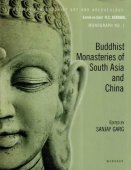Jetavanarama, Jetavanārāma, Jetavana-arama: 1 definition
Introduction:
Jetavanarama means something in the history of ancient India. If you want to know the exact meaning, history, etymology or English translation of this term then check out the descriptions on this page. Add your comment or reference to a book if you want to contribute to this summary article.
India history and geography
Source: archive.org: Ceylon Branch of the Royal Asiatic Society 1963Jetavanārāma is the name of an ancient locality that once existed near Polonnaruva (Polonnaruwa), Ceylon (Sri Lanka).—To north of the Ālāhana Pariveṇa were:—[...] Jetavanārāma, the largest monastic establishment at Polonnaruva, built by Parakkamabāhu I. It comprised:—(a) the Tivaṅka Image House for the Tivaṅka Image, now popularly known as Demala-mahasāya; (b) a beautiful, circular Temple of stone for the Tooth Relic: this is the circular ruin to south of the Tivaṅka Image House; (c) 8 stone ponds, of which 4 are named:—Vaṭṭanahānakoṭṭha, Guhānahānakoṭṭha, Padumanahānakoṭṭha, the present Lotus Bath, and Bhaddanahānakoṭṭha; (d) a vast Pāsāda for the Mahāthera Sāriputta; and (e) several other smaller buildings. The Nammadā, canal branched off from the Candabhāgā canal by the corner of Jetavanārāma.

The history of India traces the identification of countries, villages, towns and other regions of India, as well as mythology, zoology, royal dynasties, rulers, tribes, local festivities and traditions and regional languages. Ancient India enjoyed religious freedom and encourages the path of Dharma, a concept common to Buddhism, Hinduism, and Jainism.
See also (Relevant definitions)
Partial matches: Jetavana, Arama.
Full-text (+12): Potthasata, Aggabodhi Parivena, Kassapasena-vihara, Sirisamghabodhi-parivena, Kassapasena, Tivanka, Padumanahanakottha, Sirisamghabodhi, Bhaddanahanakottha, Demalamahasaya, Manipasada, Minipa, Kassapa-pasada, Manimekhala-pasada, Vattanahanakottha, Guhanahanakottha, Minimevula-pasada, Mahaparivena, Alahana-parivena, Jetavana-thupa.
Relevant text
Search found 3 books and stories containing Jetavanarama, Jetavanārāma, Jetavana-arama, Jetavana-ārāma; (plurals include: Jetavanaramas, Jetavanārāmas, aramas, ārāmas). You can also click to the full overview containing English textual excerpts. Below are direct links for the most relevant articles:
Dhammapada (Illustrated) (by Ven. Weagoda Sarada Maha Thero)
Verse 287 - The Story of Kisāgotamī < [Chapter 20 - Magga Vagga (The Path)]
Verse 131-132 - The Story of Many Youths < [Chapter 10 - Daṇḍa Vagga (Punishment)]
A Short history of Lanka (by Humphry William Codrington)
Chapter IV - The Polonnaruwa Kings (1070 AD—1215 AD)
Chapter III - The medieval kingdom to the Chola conquest in the eleventh century (479 AD—1070AD)
Vastu-shastra (5): Temple Architecture (by D. N. Shukla)
Temple architecture in Siam (Thailand) < [Chapter 12 - History of Hindu Temples (Prāsādas and Vimānas)]
Related products
